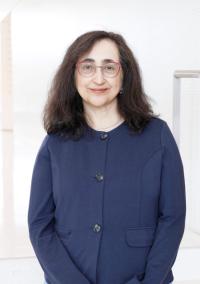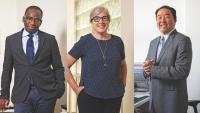
Overview
Parisa Tehranifar, DrPH, is a cancer epidemiologist with additional training and expertise in sociomedical sciences and implementation science. Dr. Tehranifar strives to reduce the burden of cancer with an emphasis on populations facing structural barriers to health, including racial and ethnic marginalization and socioeconomic disadvantage. Dr. Tehranifar’s research program focuses on: (1) understanding social determinants and mechanisms of cancer risk and outcomes and related chronic disease risk factors, (2) optimizing equitable cancer prevention and screening (3) working to identify and remedy unequal distribution of benefits and harms of emerging knowledge and interventions, and (4) promoting the adoption of evidence-based interventions or policies into public health and healthcare practice. She prioritizes community perspectives and participatory approaches and aims to integrate them in advancing the science and practice of cancer control and beyond. Her current studies, funded by NCI and NIHMD, contribute to improving breast cancer risk stratification, improving the implementation of breast and cervical cancer screening, and intervention studies to reduce risk factors for multiple chronic diseases.
Dr. Tehranifar directs the DrPH program in Epidemiology and teaches applied data analysis and field methods in epidemiologic research, and co-leads the the epidemiology department’s Chronic Disease Epidemiology Unit. She is the Co-Director of the Community Outreach and Engagement Office of the Columbia University Herbert Irving Comprehensive Cancer Center and a member of its Population Science Program.
Select Projects and Collaborations
New York Mammographic Density (NY MaDe) Study: This ongoing study investigates mammographic breast density and breast cancer screening and prevention behaviors in a socially diverse population.
Rethink Initiative: This project focuses on understanding and addressing the over-use of breast cancer screening in older women.
Integrating Mammograms in Analyses of Genes and Environment in Sisters (IMAGES): Building on the prospective family history-enriched Sister Study cohort, study examines the contribution of longitudinal mammographic breast density patterns to improving clinical risk stratification and performance of several risk prediction models that form the basis for risk-based breast cancer surveillance and preventive care. In collaboration with Black Women’s Health Study investigators, we are expanding this work to evaluate the application of mammogram-based deep learning methods for improving risk stratification and screening (ERASE BC).
Improve Chronic disease Outcomes through Multi-level and Multi-generational approaches Unifying Novel Interventions and Training for health EquitY (COMMUNITY) Center: The mission of the COMMUNITY Center is to reduce health disparities in multiple chronic diseases in the New York City Region through research and sustainable interventions that incorporate individual, interpersonal, community and societal approaches.
DISRUPT: Diversity & Inclusion in Scientific Research Underpinning Prevention & Therapeutic Trials: This project is working to improve representation of Black, Indigenous, Latinx, Asian, People of Color, people with health conditions and impairments, and LGBTQ+ persons in clinical trials by “disrupting” norms at the community, patient and provider, and research pipeline levels.
Center for SOcial CApital (SoCa): The mission of the SoCa Center is to bring together academic institutions, community-based organizations, and a diverse group of stakeholders to reduce cancer health inequities due to persistent poverty in New York City by promoting multi-generational health and increasing workforce diversity.
Academic Appointments
- Professor of Epidemiology at CUMC
Administrative Titles
- Director, DrPH Program, Epidemiology
- Co-Director, Office of Community Outreach and Engagement (COE), Herbert Irving Comprehensive Cancer Center
Credentials & Experience
Education & Training
- BA, Hunter College, City University of New York
- MPH, Hunter College, City University of New York
- DrPH, Columbia University Mailman School of Public Health
- Fellowship: Columbia University Mailman School of Public Health
Committees, Societies, Councils
American Association for Cancer Research (AACR)
American Society for Preventive Oncology (ASPO)
Society for Implementation Research Collaboration (SIRC)
Academy Health
Editorial Boards
Behavioral Medicine
Honors & Awards
Academy of Community and Public service in recognition of exceptional community service efforts by faculty, Columbia University Irving Medical Center, 2023
Yusuf Hamied Fellowship program, Columbia University Mailman School of Public Health and CGC Mumbai, 2022
Velocity Fellowship: Columbia's Ride to End Cancer, Columbia University Herbert Irving Comprehensive Cancer Center, 2021
Faculty Leadership Scholar, Tow Foundation and Columbia University Mailman School of Public Health, 2018
Research
Research Interests
- Cancer
- Chronic disease
- Community Health
- Disparities/Inequalities in Health
- Implementation Science
- Public Health Education
- Women's Health
Selected Publications
Lee Argov EJ, Rodriguez CB, Agovino M, Wei Y, Shelton RC, Kukafka K, Schmitt KM, Desperito E, Terry MB, Tehranifar P. Breast cancer worry, uncertainty, and perceived risk following breast density notification in a longitudinal mammography screening cohort. Breast Cancer Res. 2022 Dec 21;24(1):95. doi: 10.1186/s13058-022-01584-2. PMID: 36544225.
Brotzman LE, Shelton RC, Austin JD, Rodriguez CB, Agovino M, Moise N, Tehranifar P. “It’s something I’ll do until I die”: A qualitative examination into why older women continue mammography screening. Cancer Med. 2022;00:1-9. doi: 10.1002/cam4.4758
Acheampong T, Kehm RD, Terry MB, Lee Argov E, Tehranifar P. Incidence Trends of Breast Cancer Molecular Subtypes by Age and Race/Ethnicity in the US From 2010 to 2016. JAMA Netw Open. 2020 Aug 3;3(8):e2013226. doi: 10.1001/jamanetworkopen.2020.13226. PMID: 32804214 PMCID: PMC7431997.
Pacsi-Sepulveda AL, Shelton RC, Rodriguez CB, Coq AT, Tehranifar P. "You probably can't feel as safe as normal women": Hispanic women's reactions to breast density notification. Cancer. 2019 Jun 15;125(12):2049-2056. doi: 10.1002/cncr.32002. PMID: 30768781
Tehranifar P. Rodriguez CB, April-Sanders A, Schmitt K, Desperito E. Migration history, language acculturation and mammographic breast Density. Cancer Epidemiology Biomarker Prevention. 2018 Feb 23. pii: cebp.0885.2017. doi: 10.1158/1055-9965.EPI-17-0885
Tehranifar P, Goyal A, Phelan JC, Link BG, Liao Y, Fan X, Desai M, Terry MB. Age at cancer diagnosis, amenability to medical interventions, and racial/ethnic disparities in cancer mortality. Cancer Causes Control. 2016 Apr;27(4):553-60. doi: 10.1007/s10552-016-0729-2. PMID: 26970741
Tehranifar P, Wu HC, Shriver T, Cloud AJ, Terry MB. Validation of family cancer history data in high-risk families: the influence of cancer site, ethnicity, kinship degree, and multiple family reporters, Am J Epidemiol 2015;181(3):204-12.
Tehranifar P, Wu HC, Fan X, Flom JD, Ferris JS, Cho YH, Gonzalez K, Santella RM, Terry MB. Early life socioeconomic factors and genomic DNA methylation in mid-life. Epigenetics 2013; 8(1):23-7
Tehranifar P, Neugut AI, Phelan JC, Link GB, Liao Y, Desai M, Terry MB. Medical Advances and Racial/Ethnic Disparities in Cancer Survival. Cancer Epidemiol Biomarkers Prevention. 2009 Oct;18(10):2701-8. doi: 10.1158/1055-9965.EPI-09-0305. PMID: 19789367

